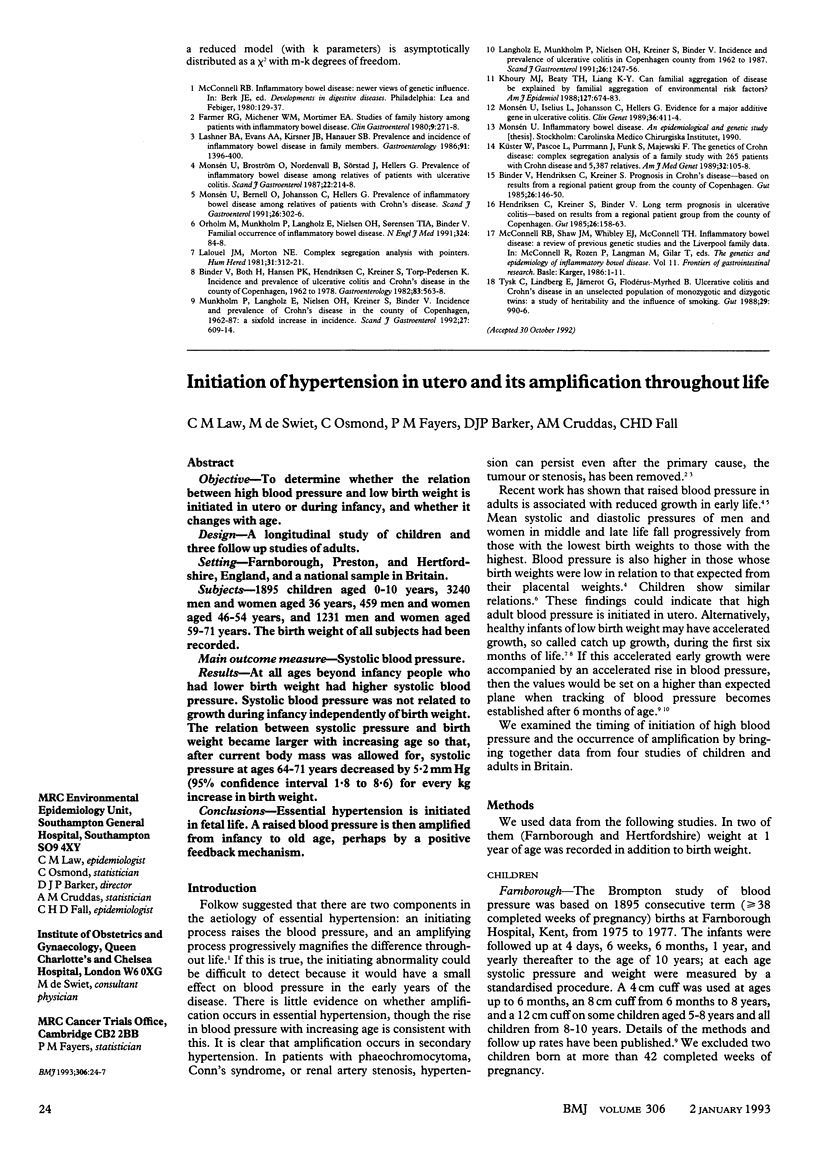Abstract
OBJECTIVE--To determine whether the relation between high blood pressure and low birth weight is initiated in utero or during infancy, and whether it changes with age. DESIGN--A longitudinal study of children and three follow up studies of adults. SETTING--Farnborough, Preston, and Hertfordshire, England, and a national sample in Britain. SUBJECTS--1895 children aged 0-10 years, 3240 men and women aged 36 years, 459 men and women aged 46-54 years, and 1231 men and women aged 59-71 years. The birth weight of all subjects had been recorded. MAIN OUTCOME MEASURE--Systolic blood pressure. RESULTS--At all ages beyond infancy people who had lower birth weight had higher systolic blood pressure. Systolic blood pressure was not related to growth during infancy independently of birth weight. The relation between systolic pressure and birth weight became larger with increasing age so that, after current body mass was allowed for, systolic pressure at ages 64-71 years decreased by 5.2 mm Hg (95% confidence interval 1.8 to 8.6) for every kg increase in birth weight. CONCLUSIONS--Essential hypertension is initiated in fetal life. A raised blood pressure is then amplified from infancy to old age, perhaps by a positive feedback mechanism.
Full text
PDF



Selected References
These references are in PubMed. This may not be the complete list of references from this article.
- Barker D. J., Bull A. R., Osmond C., Simmonds S. J. Fetal and placental size and risk of hypertension in adult life. BMJ. 1990 Aug 4;301(6746):259–262. doi: 10.1136/bmj.301.6746.259. [DOI] [PMC free article] [PubMed] [Google Scholar]
- Barker D. J., Godfrey K. M., Osmond C., Bull A. The relation of fetal length, ponderal index and head circumference to blood pressure and the risk of hypertension in adult life. Paediatr Perinat Epidemiol. 1992 Jan;6(1):35–44. doi: 10.1111/j.1365-3016.1992.tb00741.x. [DOI] [PubMed] [Google Scholar]
- Barker D. J., Osmond C., Golding J., Kuh D., Wadsworth M. E. Growth in utero, blood pressure in childhood and adult life, and mortality from cardiovascular disease. BMJ. 1989 Mar 4;298(6673):564–567. doi: 10.1136/bmj.298.6673.564. [DOI] [PMC free article] [PubMed] [Google Scholar]
- Berry C. L. Hypertension and arterial development. Long-term considerations. Br Heart J. 1978 Jul;40(7):709–717. doi: 10.1136/hrt.40.7.709. [DOI] [PMC free article] [PubMed] [Google Scholar]
- Ferriss J. B., Brown J. J., Fraser R., Haywood E., Davies D. L., Kay A. W., Lever A. F., Robertson J. I., Owen K., Peart W. S. Results of adrenal surgery in patients with hypertension, aldosterone excess, and low plasma renin concentration. Br Med J. 1975 Jan 18;1(5950):135–138. doi: 10.1136/bmj.1.5950.135. [DOI] [PMC free article] [PubMed] [Google Scholar]
- Folkow B. Physiological aspects of primary hypertension. Physiol Rev. 1982 Apr;62(2):347–504. doi: 10.1152/physrev.1982.62.2.347. [DOI] [PubMed] [Google Scholar]
- Folkow B. The fourth Volhard lecture: cardiovascular structural adaptation; its role in the initiation and maintenance of primary hypertension. Clin Sci Mol Med Suppl. 1978 Dec;4:3s–22s. doi: 10.1042/cs055003s. [DOI] [PubMed] [Google Scholar]
- Hales C. N., Barker D. J., Clark P. M., Cox L. J., Fall C., Osmond C., Winter P. D. Fetal and infant growth and impaired glucose tolerance at age 64. BMJ. 1991 Oct 26;303(6809):1019–1022. doi: 10.1136/bmj.303.6809.1019. [DOI] [PMC free article] [PubMed] [Google Scholar]
- Law C. M., Barker D. J., Bull A. R., Osmond C. Maternal and fetal influences on blood pressure. Arch Dis Child. 1991 Nov;66(11):1291–1295. doi: 10.1136/adc.66.11.1291. [DOI] [PMC free article] [PubMed] [Google Scholar]
- Lever A. F., Harrap S. B. Essential hypertension: a disorder of growth with origins in childhood? J Hypertens. 1992 Feb;10(2):101–120. doi: 10.1097/00004872-199202000-00001. [DOI] [PubMed] [Google Scholar]
- Ounsted M. K., Cockburn J. M., Moar V. A., Redman C. W. Factors associated with the blood pressures of children born to women who were hypertensive during pregnancy. Arch Dis Child. 1985 Jul;60(7):631–635. doi: 10.1136/adc.60.7.631. [DOI] [PMC free article] [PubMed] [Google Scholar]
- Scott A., Moar V., Ounsted M. Growth in the first four years: I. The relative effects of gender and weight for gestational age at birth. Early Hum Dev. 1982 Oct;7(1):17–28. doi: 10.1016/0378-3782(82)90004-4. [DOI] [PubMed] [Google Scholar]
- Wadsworth M. E., Cripps H. A., Midwinter R. E., Colley J. R. Blood pressure in a national birth cohort at the age of 36 related to social and familial factors, smoking, and body mass. Br Med J (Clin Res Ed) 1985 Nov 30;291(6508):1534–1538. doi: 10.1136/bmj.291.6508.1534. [DOI] [PMC free article] [PubMed] [Google Scholar]
- de Swiet M., Fayers P., Shinebourne E. A. Blood pressure in first 10 years of life: the Brompton study. BMJ. 1992 Jan 4;304(6818):23–26. doi: 10.1136/bmj.304.6818.23. [DOI] [PMC free article] [PubMed] [Google Scholar]


